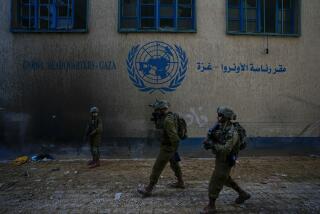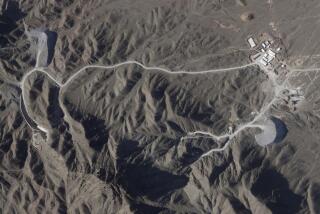Underground Shelters Built for Soviet Leaders : System May Be Used to Direct Nuclear War, Carlucci Says
WASHINGTON — The Soviet Union has constructed a vast and “enormously expensive” system of underground shelters and command facilities to allow Soviet leaders to wage a protracted nuclear war, Defense Secretary Frank C. Carlucci said Friday.
In the first extensive public discussion of the Soviet defense system, Carlucci said the Soviets for 40 years have carried out a “multifaceted program” for protecting top political and military leaders that includes deep underground command bunkers, secret subway lines, tunnels and sophisticated communications systems.
The underground shelters--some of them hundreds of yards beneath the earth’s surface--are designed to house the entire Soviet Politburo and the Central Committee and the key leadership of the Ministry of Defense and the KGB secret police, according to the Pentagon study “Soviet Military Power,” which Carlucci released Friday.
Could Survive for Months
The shelters beneath Moscow and other leadership relocation facilities outside major Soviet cities are protected against radiation and chemical warfare agents and are stocked to allow their occupants to survive and wage war for months, the report said.
“There can be only one purpose for these shelters--to provide the Soviet leadership the ability to fight a protracted nuclear conflict,” Carlucci said.
“These facilities contradict in steel and concrete Soviet protestations that they share President Reagan’s view that nuclear war can never be won and must never be fought. These facilities reveal that they are preparing themselves for just the opposite,” he said.
Carlucci cited the underground survival system as just one of several examples of contradictory Soviet rhetoric and actions. In his preface to the annual study of Soviet military strength, Carlucci noted that Soviet leader Mikhail S. Gorbachev has spoken of reducing armaments to a level of “reasonable sufficiency” and hinted of a change in Soviet military doctrine away from an emphasis on offense to a defensive posture.
Spending Has Not Slowed
However, military spending in the Soviet Union has not slowed, Carlucci said, and a massive amount of hardware already in production will continue to pour out of Soviet defense plants even if military budgets were to shrink, Carlucci said.
“Although we certainly hold out the hope for meaningful change, we’ve seen no discernible evidence of the Soviets changing the offensive nature of their force structure and deployment patterns,” Carlucci told a news conference Friday. “Indeed, the force posture and military capabilities detailed in this book are not consistent with a defensive posture.”
Carlucci called the underground shelter system “an enormously expensive undertaking for a Soviet economy that is already strapped.” He said U.S. intelligence services are trying to produce an estimate of the program’s cost; the “Soviet Military Power” publication says it rivals the cost and scale of Soviet offensive strategic arms programs.
Counterweapons Planned
Carlucci also disclosed that the United States has a number of weapons under development designed to destroy the Soviet underground command bunkers “at a fraction of the cost” of the Soviet shelters.
He declined to discuss the U.S. weapons systems, saying they are classified, but it is known that the Pentagon is working on a nuclear missile designed to burrow into the ground and destroy subsurface facilities.
The report says the underground facilities are directly linked to the main Soviet power centers. “They provide the leaders of the various organs of state control the opportunity to move from their peacetime offices through concealed entryways down to protective quarters below the city, in come cases, hundreds of meters down.”
Soviet leaders can remain in these bunkers beneath Moscow, the report says, or make their way to underground complexes outside the city “where they plan to survive nuclear strikes and to direct the war effort.”
‘Secret’ Subway Line
Another option for Kremlin leaders is to take a “secret” subway line to Vnukovo airfield 17 miles southwest of Moscow and fly from there to safe facilities in the interior. The Soviets have also refurbished empty mine shafts and tunnels for civil defense and command centers, according to the study.
The Soviet defensive system “differs both in quantity and quality from any program that we have,” Carlucci told reporters Friday. In the 1950s, he said, the United States built some limited, shallow facilities for evacuation of civilian and military leaders, but most have been abandoned, he said.
On other subjects, the Pentagon report said the Soviets have improved their military position in the last year with the addition of the following weapons: the rail-mobile SS-24 nuclear missile; the SS-N-21 sea-launched cruise missile; a fourth Kiev-class aircraft carrier; the new Mainstay airborne warning and control system (AWACS) aircraft.
In addition, the report said, the Soviets soon will be adding a number of new weapons systems, including: the Blackjack long-range bomber, of which 11 already have been built; an improved, more accurate version of the heavy SS-18 intercontinental ballistic missile; two new attack helicopters, code-named by the West “Havoc” and “Hokum,” expected to begin production shortly; the Leonid I. Brezhnev, a 65,000-ton aircraft carrier, under construction and expected to begin sea trials next year.
More to Read
Sign up for Essential California
The most important California stories and recommendations in your inbox every morning.
You may occasionally receive promotional content from the Los Angeles Times.










